E-mail exchange with Maldon Salt: 8/31/2023-9/1/2023 (request for a retraction of information published in the Lead Safe Mama overview article on salt)
For those new to the Lead Safe Mama website:
Tamara Rubin is a multiple-federal-award-winning independent advocate for childhood Lead poisoning prevention and consumer goods safety, and a documentary filmmaker. She is also a mother of Lead-poisoned children (two of her four sons were acutely Lead-poisoned in 2005).
- Tamara owns and runs Lead Safe Mama, LLC — a unique community collaborative woman-owned small business for childhood Lead poisoning prevention and consumer goods safety.
- Since July 2022, the work of Lead Safe Mama, LLC has been responsible for six product recalls (FDA and CPSC).
- All test results reported on this website are science-based, accurate, and replicable.
- Please check out our press page to see some of the news coverage of our work, linked here.
Published: September 1, 2023 — Friday
Before I share the full e-mail exchange from the past couple of days with (UK-based) Maldon Salt (scroll down to see those e-mails), I wanted to share a few relevant points for context.
1.) This language has always been published at the bottom of our Salt overview article (link):
“NOTE TO SALT COMPANIES:
If you work with a salt company and you have recent (independent, third-party) test results you would like to share with me (in a PDF form that I can publish on this website and link to your company listing above), please e-mail me at TamaraRubin@mac.com. I will also update the list above accordingly if your test results are different than the ones reported here.”
2.) An explanation of the information shared in the Salt overview article:
-
- “So what is this list? It’s a list — a work in progress — of various companies that produce (mine, collect, gather), package, and sell salt for use in cooking, along with how much Lead (in parts per billion) is known to be in each brand of salt (in most cases, as reported by the producer of the product). Gina and other Lead Safe Mama friends and readers either contacted companies directly for this information or found it online in their publicly available product information. In some cases, they were able to collect this information from other independent sources who did testing of products from that brand.”
3.) Update from Maldon Salt this week (questions/ concerns/ considerations):
-
- Maldon Salt contacted us this week to inform us that their salt has, according to their e-mail, a “less than 10 ppb” test result for Lead (based on testing the company appears to have done earlier this year in April/May 2023).
- First and foremost, it is great news to hear that Maldon Salt is reporting a “less than 10 ppb” test result for Lead in their salt; until now, I have not heard of any salt brand that has a test result for Lead (from a verified independent lab) that was as low — so if this is correct, it will be an unprecedented first!
- I also understand — and think it’s great — that, in light of this, Maldon is quite eager to “set the record straight.”
- This update (which originated from an e-mail I received this week out of the blue from Maldon Salt, see screenshots of the emails below) is a good first step.
- In support of this assertion (and at my request), Maldon has sent me a PDF of what appears to be a heavily redacted copy of a lab test result for five batches of salt that tested “negative” for Lead (given a low threshold of detection of 10 parts per billion).
- Maldon has also “asked” — actually demanded — that I not publish the test results they sent me. (To honor their request, at least for the moment, I made a very blurry copy of their report and took a screenshot of it [above]. What you can see in this image is all the redacted lines of the report — the areas with heavy black irregular lines across them — but none of their data is visible.)
- What I don’t understand is Maldon Salt’s motivation for including what seems to be a veiled threat (with firm and repeated language) to not disclose their provided evidentiary data for the requested update/correction, especially when publishing that information would appear to be in their benefit.
- As you can see from the above (point #1), we invite input with new data and/or proposed corrections by companies — but also clearly state that our policy is to publish the PDFs of test results, which include any new or contradictory data with these updates (test results from a valid independent lab/COA constituting proof of any contradictory data) on this website. It is not reasonable to accept these sorts of claims without proof, of course. Yet once we have proof in hand, it is appropriate — and vital — (in the interest of full transparency) to share these reports with the public (especially if the result would be adding an exceptionally low-Lead salt to the list of “Best Choices”)!
4.) How do you explain the discrepancy between the previously reported 700 ppb and Maldon’s self-reported “less than 10 ppb” noted in the e-mail exchange below?
-
- The 700 ppb (parts per billion) was a level reported in our Facebook group in 2018.
- A Lead Safe Mama community volunteer (and medical professional) researching the subject of Lead in salt compiled a list of data comprised of Lead levels for many salts and this is one of the pieces of data she discovered during her initial research.
- The company is currently self-reporting a level of “less than 10 ppb.”
- The pdf image that the Maldon Salt representative sent me (which, as you can see from the e-mail thread below, they asked me to keep “confidential”) is dated May 15, 2023 (reporting on testing completed on April 14, 2023), so it is possible the Lead levels in their salt may have changed (improved) over time (in the past five years).
- It’s possible that our reported 700 ppb was a batch-specific anomaly.
- It’s also possible that the company learned of our reported test results when we published the initial summary back in October 2020 and has made a concerted effort to clean up their product since then.
- Frankly, the above possibilities are pure speculation. It is hard to know either way without additional testing (or without reviewing multiple different reports across a generous time frame such as a full year) so we can see the range of results for their products currently.
- I have followed up with Gina (the volunteer who assembled most of the content of this list for the Lead Safe Mama parent advocacy community) to confirm the source of the previously reported 700 ppb, and will report back here as soon as I have that specific information.
- Important to note: sustained periodic testing (at regular intervals) is required to confirm the ongoing safety of any food product (including salt, spices, and supplements) over time. Said another way, just because a company sends one or more batch samples to a lab for testing (at one specific point in time) doesn’t guarantee that those test results are consistent across all batches over a month, year, or many years. (Note: In our communication thread, Maldon Salt did however claim that they “routinely” test [without giving any specifics about intervals].)
- To be clear, I don’t have any specific reason to doubt Maldon’s self-reported “less than 10 ppb,” but the PDF of the attached “certificate” they included in the e-mail as evidence for their requested correction (the PDF they demanded I not share publicly) was oddly a heavily-“redacted” document (basically, nearly every line of the entire document was crudely-blackened-out — every and all heavy metals results other than Lead)! Perhaps this was done for some innocent, if misguided, reason.
- Had they sent me an unredacted PDF of their test results (along with a friendly, non-confrontational email) I would likely have simply updated the original article and linked the PDF with the data to the listing for their salt. The only reason I am hesitant to take them at their word is their choice of language in their communications and the fact that their report is heavily redacted. Frankly, I might not have questioned their test results had these considerations been part of the communication.
As noted in our e-mail exchange with the company (below), despite the clearly-stated language in the overview article (point #1 above) that we always publicly share this information (share PDFs with test results) — I am going to hold off sharing their heavily redacted report for the moment. I intend to give the company an opportunity (until next week) to respond to my most recent e-mail (sent on the morning of 9/1/2023). This gives them the “professional courtesy” to provide me an alternate “clean” (non-adulterated!) version of their testing report before I publish the bizarre “test results” they sent me, demanding that I not share the information publicly — yet the results were included as support for their request that changes be made to our overview article. I will also share a link to this article with them.
Below is the full e-mail exchange from the past couple of days, in order. There are four e-mails:
- Their 8/31/2023 e-mail to me
- My 8/31/2023 response
- Their 9/1/2023 response
- My 9/1/2023 response
Initial 8/31/2023 email from Maldon Salt
8/31 Cover note:
Text from the above note:
“Hello Tamara,
Please see attached letter that I am sending on behalf of Maldon Salt regarding your article dated October 21, 2020 titled ‘How much lead is in salt? Which salt is safest to use for cooking? Is Himalayan salt safe?’
We look forward to hearing from you as a matter of urgency
Yours sincerely
Sarah”
8/31 Attachment:
Text from the above note:
Dear Ms Tamara Rubin
Re: Your article dated October 21, 2020 titled ‘How much lead is in salt? Which salt is safest to use for cooking? Is Himalayan salt safe?’
We write further to your article published on your blog ‘Lead safe Mama’, dated October 21, 2020 titled ‘How much lead is in salt? Which salt is safest to use for cooking? Is Himalayan salt safe?’
Within your blog you incorrectly claim that Maldon Sea Salt flakes have levels of at lead at 700 ppb.
We do not know why you made this statement because it is untrue.
Maldon salt carries out regular testing of our salt and the latest analysis report put the lead level at less than 10ppb.
You will appreciate that it is very important that false statements should not be put into circulation about our products as they have the potential to cause serious damage.
We would ask that you please confirm to us by return email that you will remove this incorrect information and refrain from making this claim about our products again, whether in writing, via the internet or social media or otherwise.
If you will please provide us with that confirmation, we will treat this matter as closed. We look forward to hearing from you as a matter of urgency.
Yours faithfully,
Sarah Currie
Senior Brand Manager Maldon Crystal Salt Company
My 8/31/2023 response email:
Text from my initial response:
Please send us the independent lab testing (COA / Certificate of Analysis) you have that demonstrates lead levels different from what our volunteer found from other sources and we will update our article.
Thank you.
Maldon Salt’s 9/1/2023 response:
Text from the above note:
Hello Tamara
Thank you for your email reply.
In good faith, I attach our latest test certificate including the relevant information on our lead testing. This is a business confidential report which I am sharing for your own reference to verify the information I shared with you in my earlier email.
Do not share this onwards with any other party, or in any other format, in part or in its entirety. For absolute clarity, you do not have permission to share this report on your blog or any digital or social channels or printed media channels.
The report confirms that our sea salt levels have less than 0.01mg/kg, which is the same as 10ppb. At the time we ran this report we only sold our original Maldon Sea Salt Flakes.
We appreciate your prompt update to your blog, reflecting the correct information and removing the incorrect data.
Please confirm once you have actioned this and I will consider the matter closed.
Yours sincerely,
Sarah
My 9/1/2023 response:
Text from my second response:
Your assertion is that your testing sheds favorable light on your product and it does not make sense that you would not want to share that information publicly if – in fact – that information were true.
Think of me as a reporter in this instance, for that is the capacity I am serving in here. If you have information you do not want shared publicly – and if that information cannot be verified by other sources – you should not share that information.
Never Miss an Important Article Again!
Join our Email List





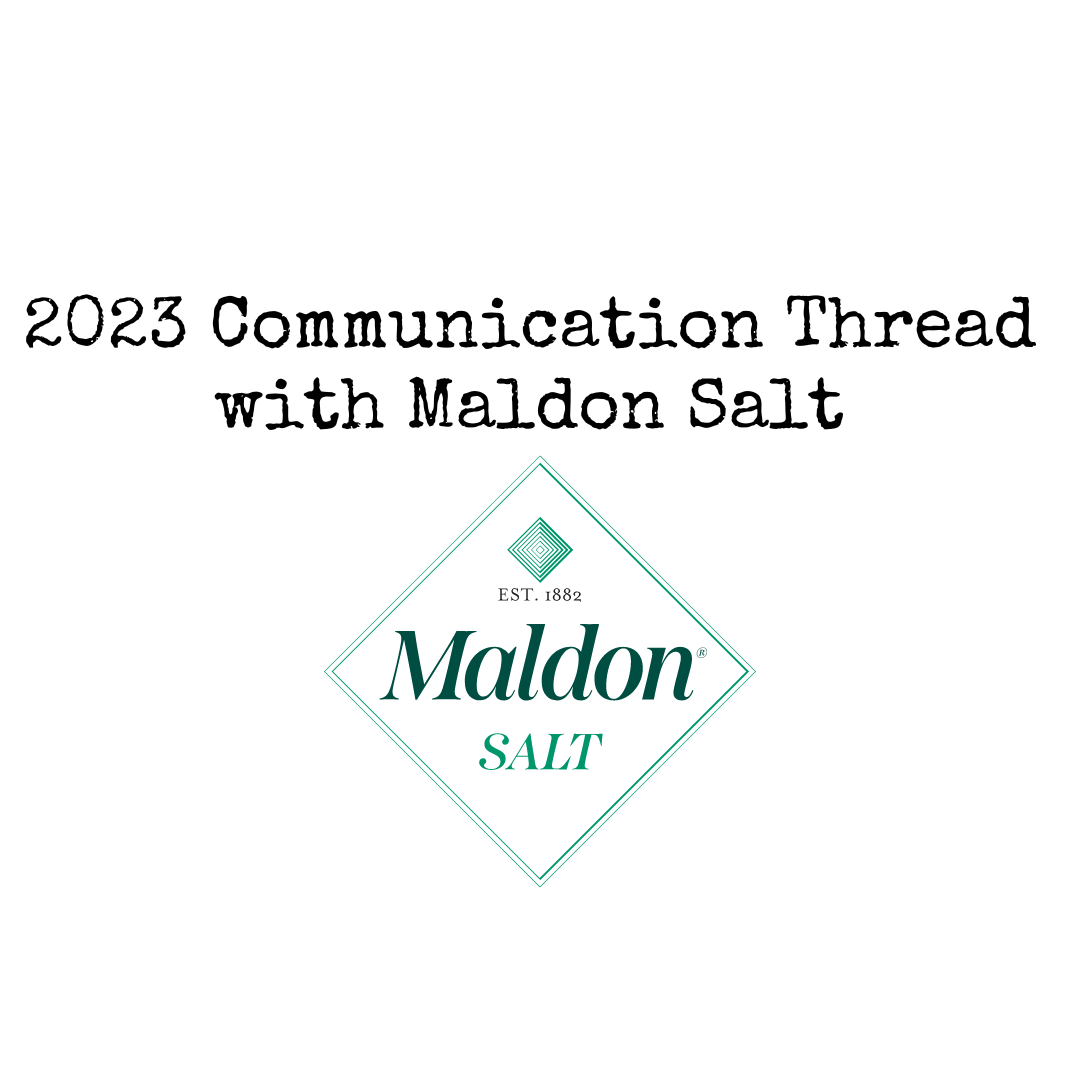

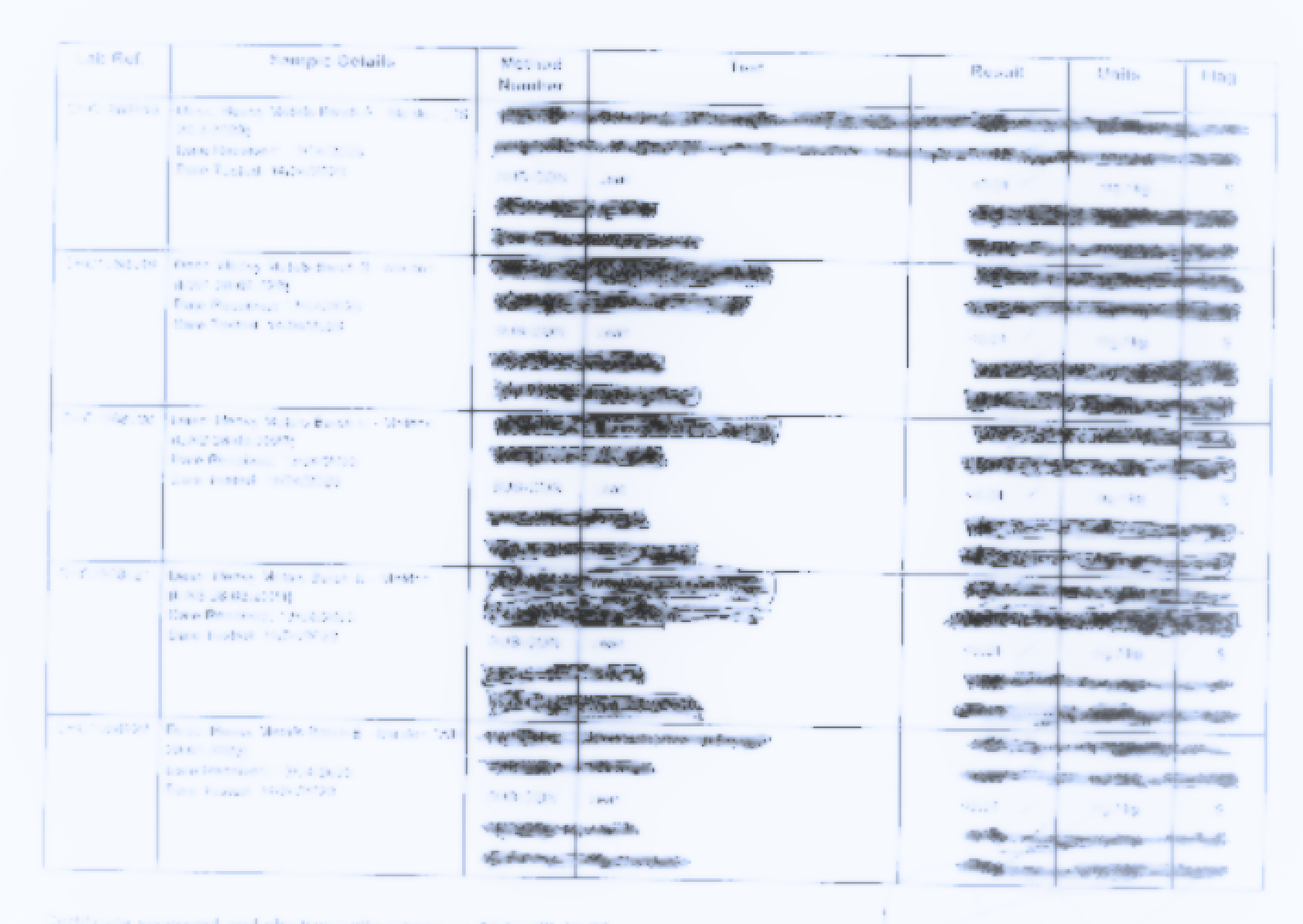
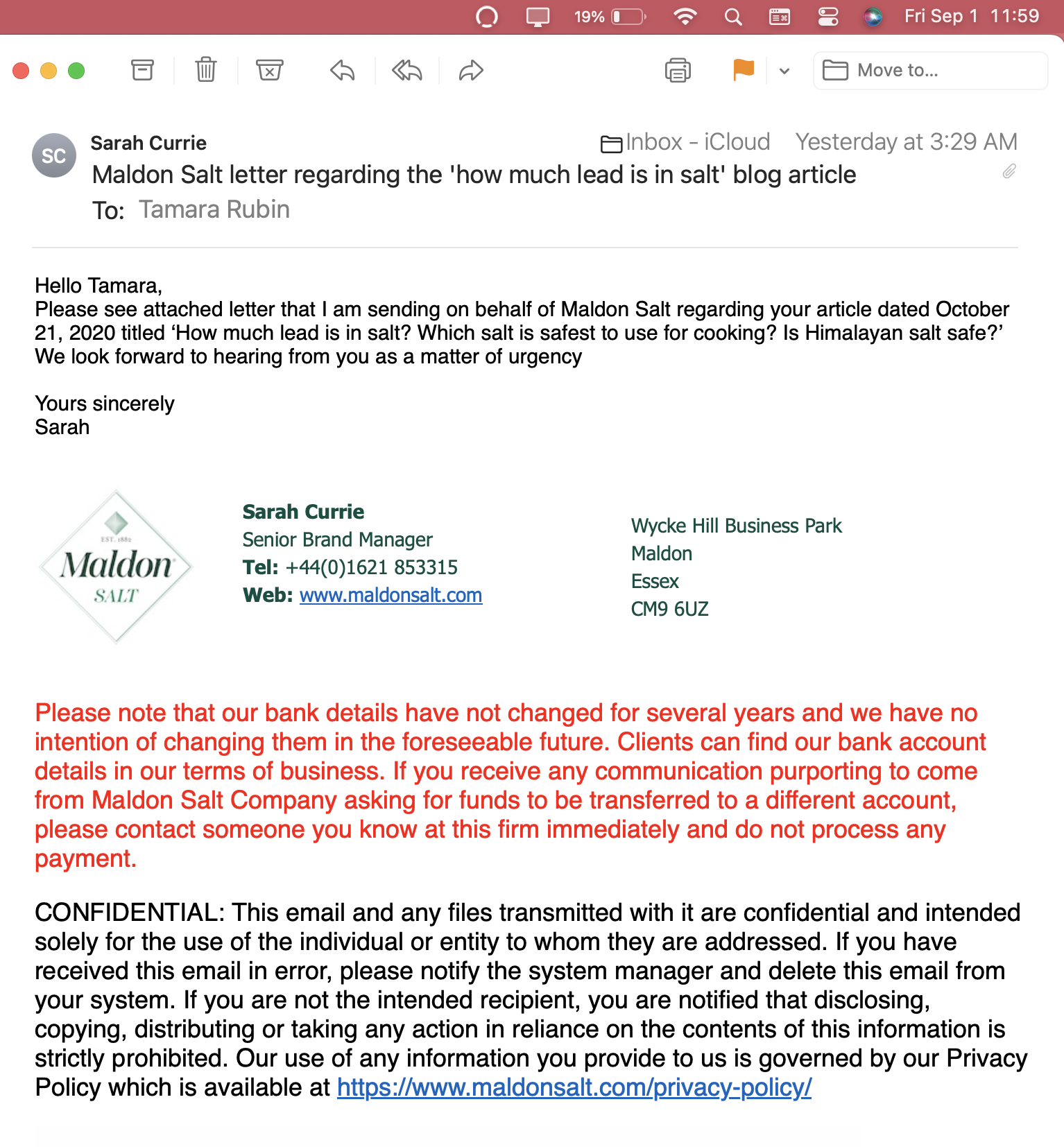
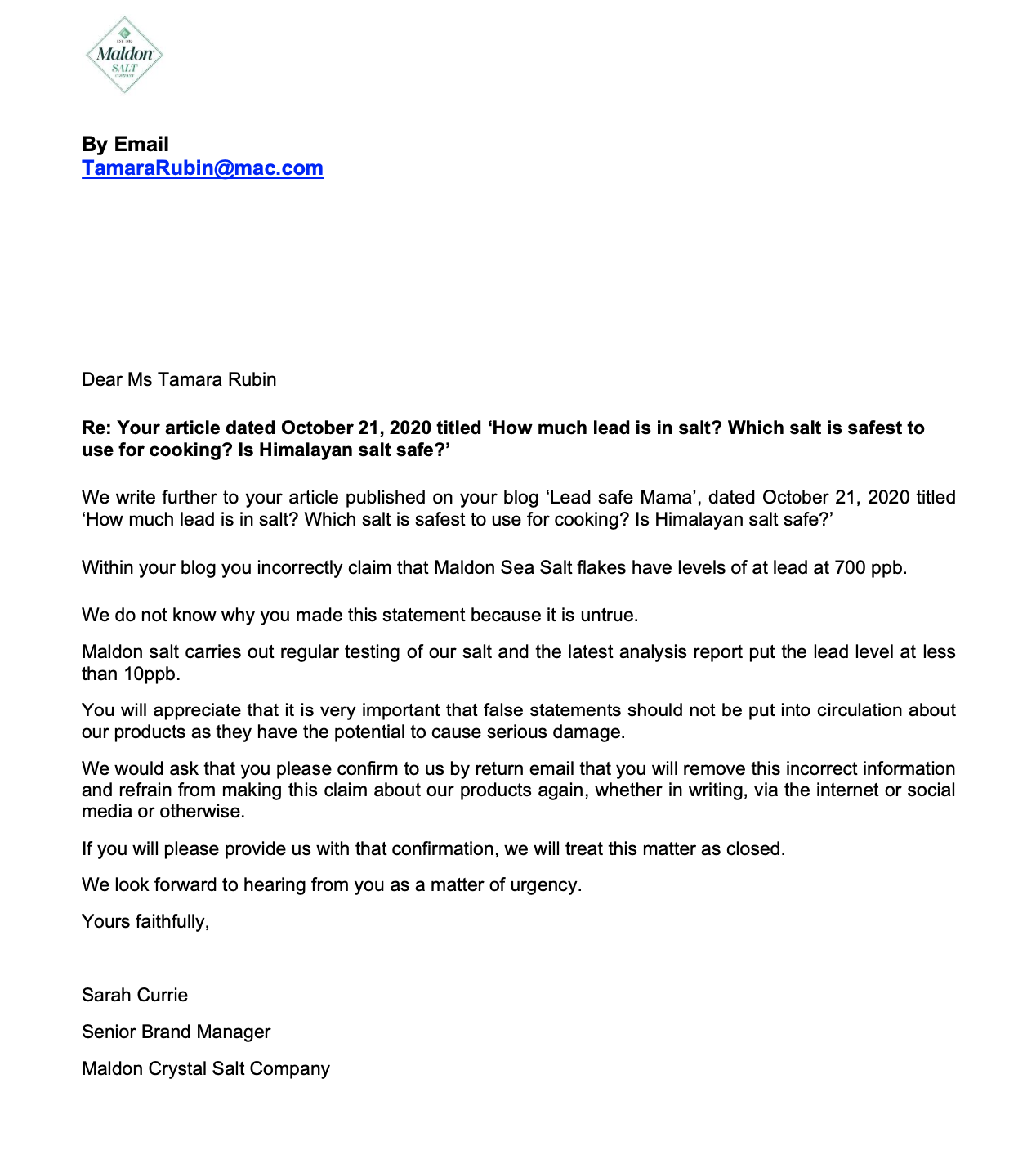
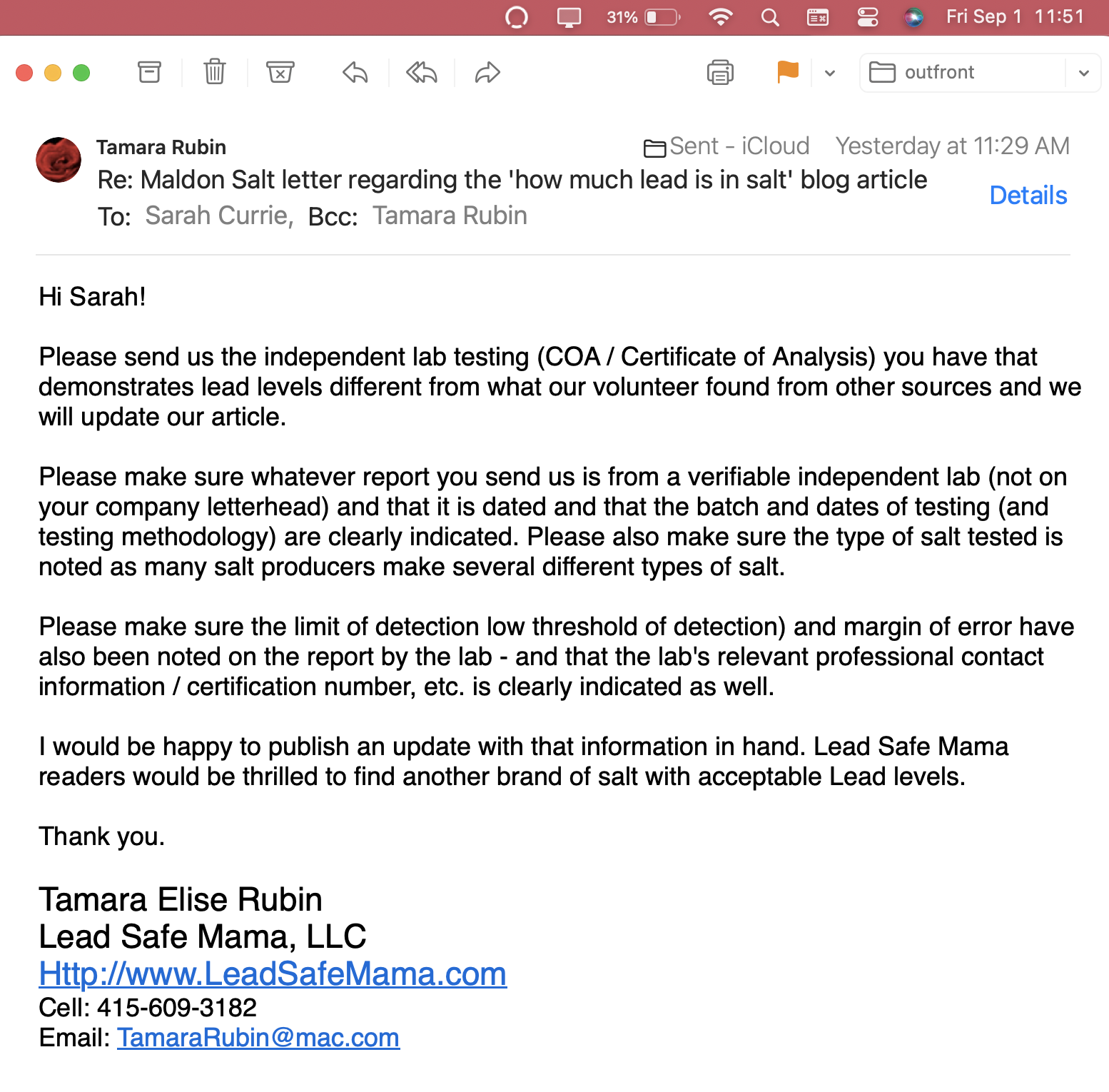
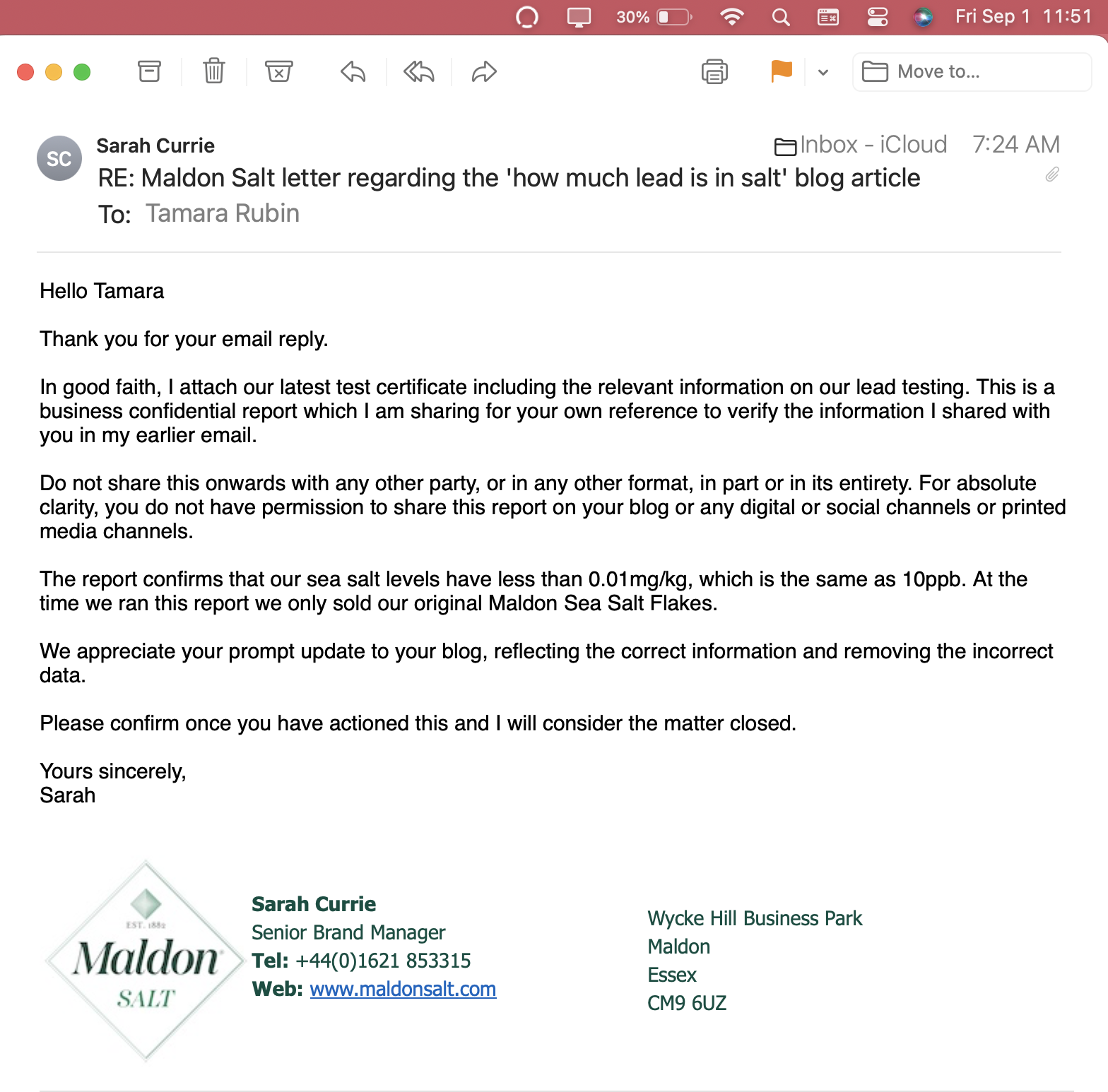
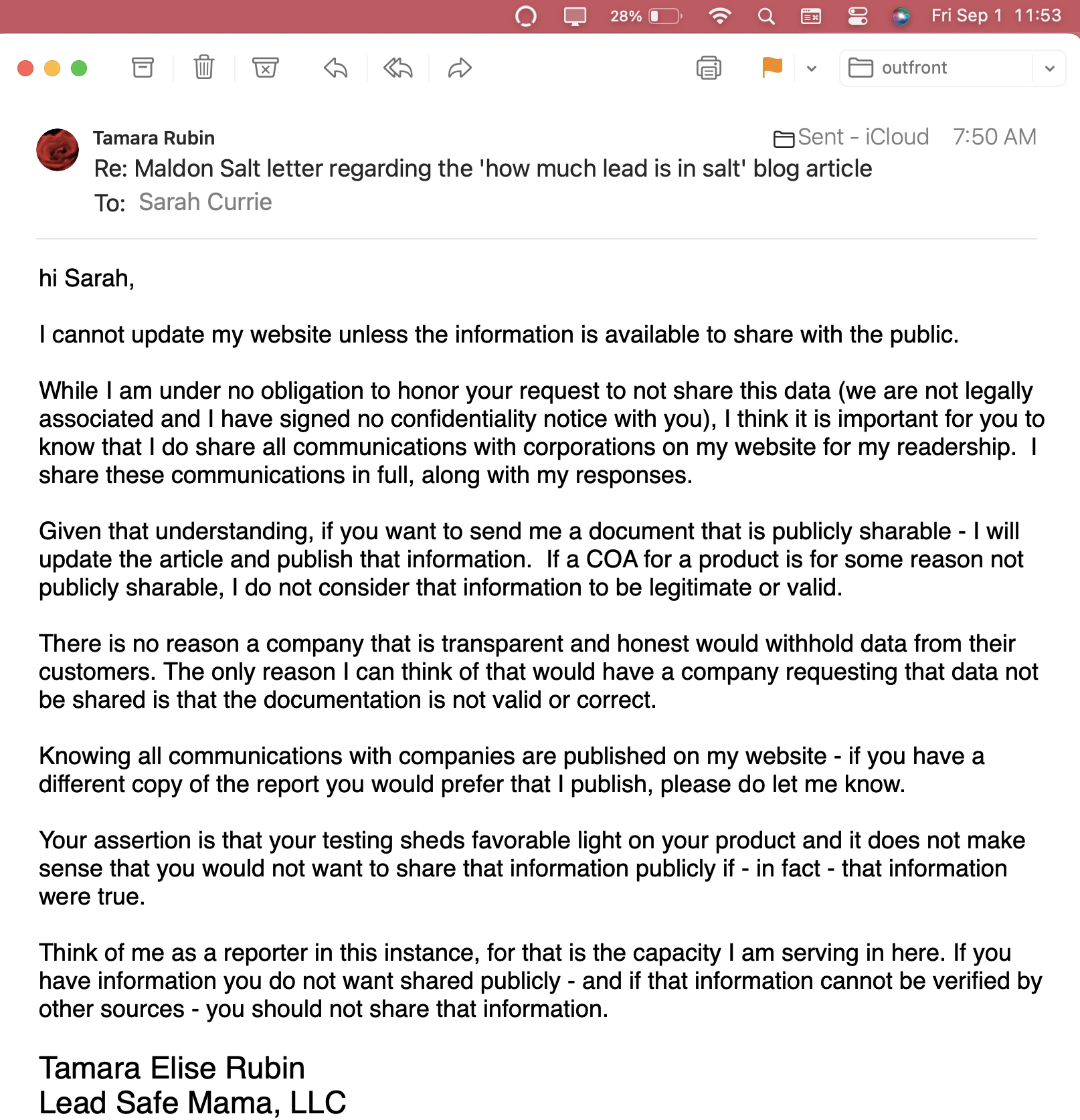

Whew. Bravo Tamara. Thanks for acting with integrity. Why is it so hard for companies (and nonprofit orgs) to do the same?
*claps* thank you for doing the hard work Tamara.
Wow, why would a company make it so difficult to let consumers know that their product is safe (if that’s really the case). It seems strange they don’t want it published.
Now I’m wondering what salt is safe…
Thanks for your hard work TRYING to get accurate information. I feel as you do that if all were on the up and up, they should be happy for you to publish the original version of the document, sans redactions. I’m guessing there are other problematic heavy metals they don’t want to show to the public and possibly create more problems for the Maldon company.
Me, just over here still crying because Redmond’s and Celtic salts were on your list.
I literally had a bottle of Maldon’s in my hands tonight in World Market and wanted to wait to buy it until I checked your list again….
Eager to see more – and hopeful that they will respond with exonerating evidence.
Also…. At World Market there was a Hawaiian salt… very interested to know where that would fall on the list…
Did Malden conduct the testing at an independent lab?
It’s absolutely unreal how it’s like pulling teeth to get the truth from companies. So sneaky. I was about to order bulk sizes of their salt for our disaster preps….but will wait on that for now. Thank you for sharing this info.
Any update on Maldon salt??
I came across this recent article which tested the mineral compositions of some gourmet salts, of which Maldon is included: https://www.ncbi.nlm.nih.gov/pmc/articles/PMC10459412/pdf/toxics-11-00705.pdf.
Really interesting study, though it’s challenging to interpret their measurements in comparison to ppb as they’re mg/Kg. However, there’s this quote:
For Pb, on the other hand, two different maximum levels are indicated depending on the class of salts:
for salts in general, the maximum permitted level is 1.0 mg/Kg while for unrefined salts
such as “fior di sale” and “grey salt”, the regulation sets a limit of 2.0 mg/Kg. In any
case, our samples always exceeded the maximum permitted levels. This is not a good
result considering that lead is a toxic element that accumulates in the body and affects
different systems and organs such as the central and peripheral nervous system and the
gastrointestinal tract [32].
In Layman’s terms, how much Lead was in Maldons sea salt?
Sez Maldon has 8000 ppb.
Wow. They are super shady. What exactly are they hiding under all that black marker? I am guessing they did not reply?
I am now at Costco in Australia, checking before I buy salt. I have just put the tub of Maldon Sea Salt Flakes back on the shelf. Thank you, Tamara xx
So is this salt safe to use?
I have not tested it personally – but they sent some follow up testing and it looks like it may be. We will be doing some follow up testing soon.
T
Hello any update on this salt? Is this salt safe?
No updates yet.
T
Wow, so I just saw an Instagram post saying that redmonds and Celtics tested high in heavy metals and maldon was safe. I never know what to believe. I know I love maldon salt on everything. I don’t like how manipulative and intimidating their communications were with you and how they were anything but transparent. I applaud your responses not to back down! It definitely sounds like they were giving you a false documentation, hoping that would cause you to redact your article but couldn’t make the documentation public because they knew it was fabricated and would come back to bite them.
Any updates on this? Keen to know… as Maldon is the only readily available salt in this part of the world (malaysia) that has potentially safe lead levels. What about microplastics?
Would love to know too, I’m in the UK and wondering whether to stick to Maldon’s or perhaps try Diamond Kosher but I can’t find any info on that, it’s stressful.
Any updates? I am also wondering about microplastics…Thanks Tamara for all that you do!
Maldon is next to a nuclear power plant and has been since 1962. I’m tossing the small jar I had in the back of the pantry right NOW!
https://www.visitmaldondistrict.co.uk/discover/history-and-heritage/nuclear-connection
Shades of Erin Brockovich!
I really wish somebody would do a full set of COAs and microplastics on Diamond Crystal salt. We seem to have a Ton of conflicting info and confusion on its purity, as some claim to have run labs (questionable) and it came back pristine but Tamara received no response to inquiries for COAs. It is readily available, but without labs, could be as bad as Maldon’s.
Any 2025 updates on Maldon salt’s lead content and/or other contaminants? Thanks.
https://pmc.ncbi.nlm.nih.gov/articles/PMC10459412/
From 2022
Just found mention that Maldon is like “feet away” from the Bradwell nuclear power plant and has been since the plant opened in 1962-2002. Chernobyl salt? No thank you! Venting into the ocean, ponds, underground waste storage tanks…and a salt company on the edge of it all? All that glitters isn’t fit for consumption. No wonder they don’t want anyone seeing their labs!! Best advice for nowadays: Caveat Emptor. No salt is worth *this* risk – no matter how pretty or prismatic, IMHO.
“Over the next three years, all spent nuclear fuel was removed and by 2011, the turbine hall was demolished. Five years later in 2016, the underground waste storage vaults were emptied and decontaminated.”
“The most recent works have included the demolition of all buildings except the ponds and two reactor buildings in 2019, with the reactor buildings demolishion and final site clearance scheduled for some time between 2083 and 2093.”
https://www.visitmaldondistrict.co.uk/discover/history-and-heritage/nuclear-connection
The hiddens on Maldon…and enough evidence historically to avoid it outright. With this evidence, we can likely now save time and just retire this question about why Maldon won’t share COAs…and what it is really “made of,” both salt and company. Now, we have, as Paul Harvey would say, “The rest of the story.”
If you don’t want to consume the research below, here’s the summary:
Salt harvested from saltmarshes at the back of an inlet who has at its mouth an operational nuclear power plant since 1962, admits it uses/used “leddies” or lead pans and coal furnaces, and still cooks in metals pans (leaching) from that inlet water, “boiling water to remove impurities,” accomplishing nothing of value. Pics in the links below accompany evidence.
https://en.m.wikipedia.org/wiki/Maldon_Sea_Salt
Sea salt production in the coastal town of Maldon dates back to the time of Roman Britain when clay-lined salt evaporation ponds were constructed, and according to the Domesday Book, 45 lead pans were used to manufacture salt there in 1086.[2]
The Maldon Salt Company was founded under its current name in 1882, having previously been part of a local coal firm.[3]
__________________
https://foodism.co.uk/features/long-reads/origins/decades-old-traditions-british-maldon-sea-salt/
—Scraping continually occurring in these large aluminum, or still lead?, pans and leaching into the brine water that the salt is in before drying. Lots if greenwashing terms, likely things that boost their profits and cut expenses but they put marketing spin on it to avoid making a safe, clean product.
“Thousands of gallons of seawater from the saltmarshes” (the “marshlands of Essex”)
“We boil the water to remove impurities.”
How does that work on metals and radioactivity and microplastics?!
You can see the salt-harvester guy standing in the same seawater that is a stone’s throw from the entire nuclear power plant to the ocean, in the pic.
“Needless to say, it’s not competition that keeps Steve awake at night.”
No, hopefully it’s a guilty conscience!
_________________________
https://en.m.wikipedia.org/wiki/Bradwell_nuclear_power_station
If you expand the map, you can see that Bradwell’s nuclear plant is right at the Mouth of the Inlet to Maldon, meaning all the water goes Past Bradwell to reach and soak in those marshlands. The picture of the plant under Future Plans shows Bradwell’s full station right at ocean’s edge. I am starting to understand why those COAs Maldon sent to Tamara were so heavily redacted!
https://www.essexlive.news/news/history/old-essex-raf-airfield-became-9226033
BTW, I took screenshots of all those links and articles on Maldon and Bradwell, in case someone tries to alter or suppress them, including the pictures of the aerial of the power plant and Maldon’s back of the inlet location after the water cruises past the nuclear facility(!!).
Tamara, if you want to post those for posterity, just email me and I will send them to you, if you or anyone has problems accessing them.
Hello, any update on this particular product? Your recent article mentions this product to be heavy metal free but I cannot find the data. Thank you
interesting info angelil thanks for taking the time to post and researching it… don’t suppose any more testing has been done since to verify what maldon have put out as 10 ppb is there..?
There could be other things in their salt that tamara isn’t testing for. I have heard some salt can be radioactive?
This was definitely a concerning reaction – and I am not sure why, so that’s a great point!
T